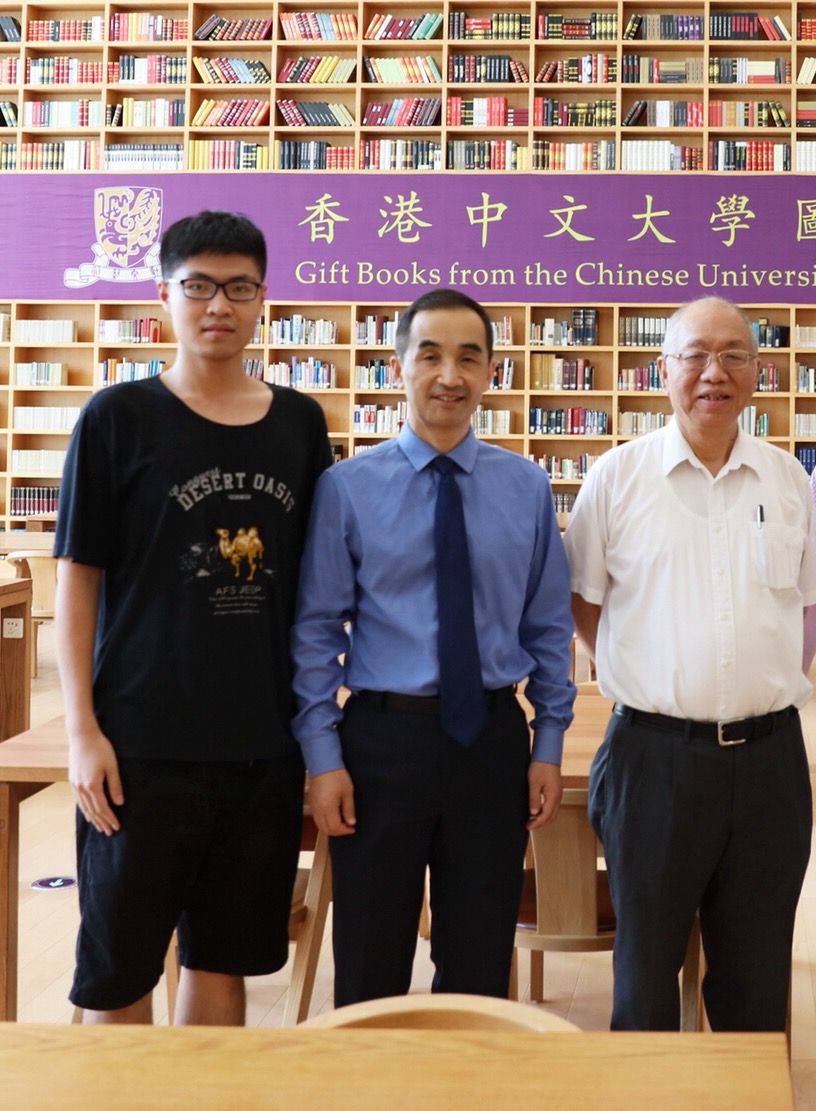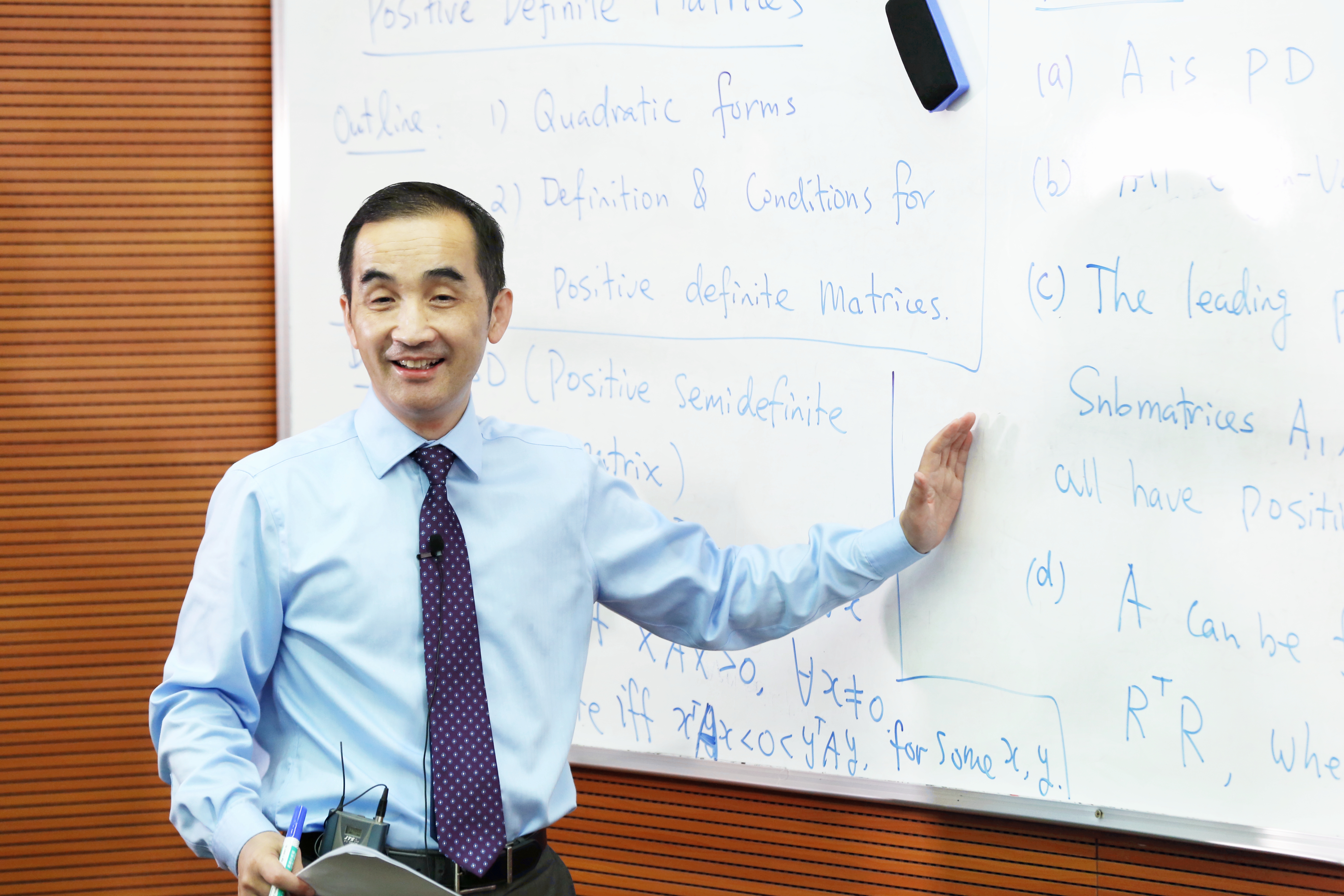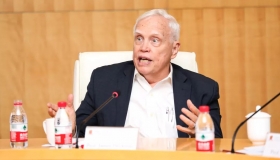ACSSC Accepts Paper by SSE Student Lin Zhen
Minimax Design of Constant Modulus MIMO Waveforms, a paper written by LIN Zhen of The Chinese University of Hong Kong, Shenzhen, was accepted by the IEEE-ACSSC conference in July 2018. Lin is now an undergraduate student majoring in Statistical Science at the School of Science and Engineering, CUHK-Shenzhen and is invited to present his paper at the conference as the first author.

Lin Zhen with Professor Tom Luo and Professor Shing-tung Yau
The Asilomar Conference on Signals, Systems, and Computers, one of the top international conferences in the field, is a yearly conference held on the Asilomar Conference Grounds in Pacific Grove, CA, USA. As an important conference for data communications, ACSSC brings together leading experts and professionals from the field of signal processing and communication systems every year to provide forums to discuss and share new ideas about theoretical and applied signal processing. The conference usually lasts four to five days, and top experts in related fields will be presenting recent and novel work at the conference.
Author Profile
Name: LIN Zhen
School: SSE
College: Shaw College
Major: Statistical Science
High School: Shenzhen Experimental School (Senior High School Department)

Tutor Profile
Prof. LUO, Zhiquan Tom
Professor Zhi-Quan (Tom) Luo received his BSc degree in Applied Mathematics from Peking University, China, in 1984. In the same year, he was selected by a joint AMS-SIAM committee and the Ministry of Education of China for graduate study in the United States (S.S. Chern Program). Following a 12-month intensive training in English and Mathematics, he enrolled in the Massachusetts Institute of Technology where he received a PhD degree in Operations Research in 1989. From 1989 to 2003, he was on the faculty in the Department of Electrical and Computer Engineering, McMaster University, Canada where he eventually served as the department head and was awarded a Canada Research Chair (Tier I) in Information Processing. From 2003 to 2014, Professor Luo has been a full professor at the Department of Electrical and Computer Engineering, University of Minnesota and held an endowed ADC Chair in digital technology. Currently, Professor Luo serves as the Vice President (Academic) of The Chinese University of Hong Kong, Shenzhen, and concurrently the Director of Shenzhen Research Institute of Big Data and also the Director of CUHK(SZ)-Tencent AI Lab Joint Laboratory on Machine Intelligence.
Paper Introduction
Conference: 2018 IEEE Asilomar Conference on Signals, Systems and Computers (ACSSC 2018)
Conference Profile:
The Asilomar Conference on Signals, Systems, and Computers, one of the top international conferences in the field, is a yearly conference held on the Asilomar Grounds in Pacific Grove, CA, USA. As an important conference for data communications, ACSSC brings together leading experts and professionals from the field of signal processing and communication systems every year to provide forums to discuss and share new ideas about theoretical and applied signal processing. The conference usually lasts four to five days, and top experts in related fields will be presenting recent and novel work at the conference.
General areas of interest to the forum include: Machine Learning, Data Analytics, Multisensor Systems, Architecture and Implementation, Array Signal Processing, Biomedical Signal & Image Processing, Communication Systems, MIMO Communications & Signal Processing, Networks, Signal Processing & Adaptive Systems, Speech, Image & Video Processing and so on. Recent meetings have presented a wide array of work ranging from Results in Blind Source Separation, Random Networks, MIMO Communications, Low Dimensional Signal Models to Applications of Signal Processing in Control, Wireless Communications, Financial Engineering, Smart Grids, Biological Systems, Medical Imaging, and Big Data.
Paper: Minimax Design of Constant Modulus MIMO Waveforms
Abstract:
Multiple-input multiple-output (MIMO) systems, as a major research direction in the field of modern radio signal processing, have many important applications in radar, active sensing, and mobile communication. The performance of a MIMO system, such as location accuracy, detection performance, and parameter identifiability, is known to be directly related to the good correlation property of its signal waveforms. In particular, it is desirable to have low auto- and cross-correlations among the designed signal waveforms which should be additionally constant modulus.
This paper considers the joint optimization of constant modulus waveforms and mismatched (or matched) receive filters to suppress the auto- and cross-correlations using the minimax (l∞) design criterion. For practical waveform length and system size, the waveform design problem becomes quite challenging due to the large problem size (more than 10^5 unimodular complex variables and 10^6 nonlinear constraints). In addition to the large size, this problem is nonconvex, nonsmooth, and as such, can not be handled effectively by the existing waveform design algorithms or off-the-shelve optimization tools. This paper develops an efficient primal-dual type algorithm with low per-iteration complexity to solve this problem. Numerical comparison shows that the waveforms based on the minimax design outperform those obtained from the existing l2 norm design by 4-5 dBs in terms of peak sidelobe levels (PSL).

Interview:
Q1: This paper focuses on the Multiple Input Multiple Output (MIMO) array system in the field of modern radio signal processing and pursues low auto- and cross-correlations among the designed signal waveforms. The research methods are highly correlated with mathematical algorithms. Why did you choose this topic? As a student of Statistical Science, you might have encounter many professional and non-professional difficulties in the research process. How did you solve these problems?
A1: I chose this topic not only because it is an important and popular topic, but also because it requires advanced mathematical knowledge and strong programming skills. It is a difficult topic. But I am particularly interested in mathematics. Choosing this topic will allow me to apply the mathematics knowledge I have acquired. In this process, I have overcome my shortcomings through self-study and become able to program my own mathematical algorithms.
In fact, this research topic itself is not very relevant to statistics, requiring very limited professional statistical knowledge. Instead, strong math and programming skills are the key. But I found that the knowledge I learned in the statistics class can be applied subtly to the research. For example, the efficiency of an algorithm is important for research, especially when dealing with such large-scale and highly complicated problems. At first, my algorithm was not efficient enough to deal with large-scale problems, so I could not do enough experiments in a limited time. Later, the discrete Fourier transform that I learnt in the statistics class gave me inspiration. I then learned and expanded other related knowledge, and based on this, I rewrote the functions of MATLAB. As a result, my own rewritten functions are much more efficient than MATLAB's own functions, which has improved the efficiency of my program by hundreds of times. I have encountered many difficult problems in the research process. I needed to spend a lot of time, thinking, trying, and learning new knowledge to solve these problems.

Lin Zhen received SSE Dean's list Award
Q2: You are also working at Shenzhen Research Institute of Big Data. Many people are curious about the institute. Can you tell me how did you enter the institute? What is your daily duty at SRIBD? Is the research mission of the Institute related to your expertise?
A2: I joined the Shenzhen Research Institute of Big Data because I felt that I could learn a lot of knowledge and skills that I couldn't learn in regular classes. More importantly, I can follow the masters like Professor LUO Zhiquan. At the same time, there are many excellent students and interesting projects in the institute.
Doing research is very different from the usual courses. When you are in class, the teacher will tell you what you are going to learn this week and specify the assignments. You will also be very clear that you will complete this course within this semester. However, there is no clear road sign for research, nor is there a fixed number of questions and scope of knowledge as homework and exams. The most significant feature of research is that it takes a lot of time and effort, which is very hard. There are always new problems and there is no guarantee that every problem can be solved eventually. You need to explore and try it yourself. A problem may not be solved even after several months of efforts. I have developed my ability to overcome difficulties through this process, which is very helpful for my usual professional study.
Copywriting | Liu Haoxiang (SSE Sophomore)




